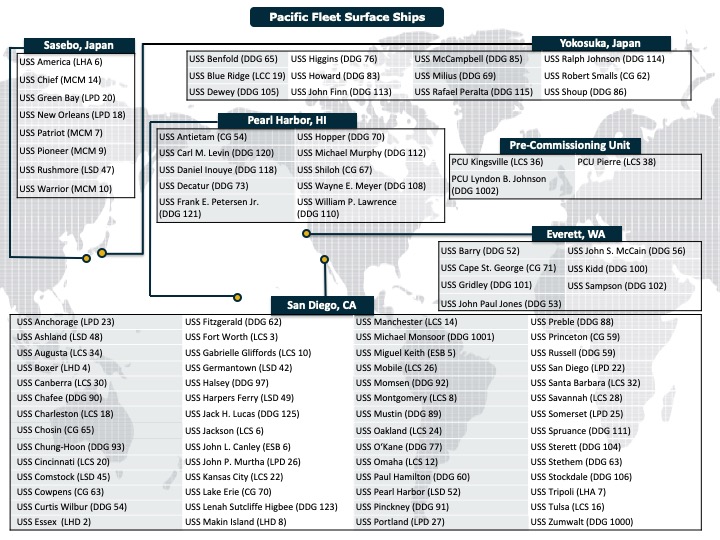Final Indy class LCS Christened
The 19th Independence-variant Littoral Combat Ship– the future USS Pierre (LCS 38)-– was christened over the weekend at Austal in Mobile.

Ship sponsor Larissa Thune Hargens executed the ceremonial bottle break over the bow of Pierre, witnessed by an audience of over four hundred guests. (Austal)
At least the end is near on the shitshow that has been the LCS program.
Granted, while the Indy class vessels have been less flawed than the 16-ship Freedom class built by Lockheed Martin (Marinette Marine), that is a low bar.
Anywho, it seems the Indies have at least matured to the point that they may be a viable minehunter that can carry a few anti-ship missiles and perform some low-risk flag-waving and surveillance tasks. After all, the Navy’s first Mine Countermeasures Mission Package (MCM MP) just arrived aboard Indy class sister USS Canberra (LCS 30) late last month and four of the class will deploy to the Middle East in 2025 in the MCM role.

An unmanned surface vehicle is craned aboard the Independence-variant littoral combat ship USS Canberra (LCS 30), as a part of the first embarkation of the Mine Countermeasures (MCM) mission package, on April 23. The MCM mission package is an integrated suite of unmanned maritime systems and sensors that locates, identifies, and destroys mines in the littorals while increasing the ship’s standoff distance from the threat area. Littoral Combat Ships are fast, optimally manned, mission-tailored surface combatants that operate in near-shore and open-ocean environments, winning against 21st-century coastal threats. (U.S. Navy photo by Mass Communication Specialist 1st Class Vance Hand)
As detailed by NAVSEA:
An integrated suite of unmanned maritime systems and sensors, the MCM mission package locates, identifies, and destroys mines in the littorals while increasing the ship’s standoff distance from the threat area. Embarked with the MCM mission package, an LCS or a vessel of opportunity can conduct the full spectrum of detect-to-engage operations (hunt, neutralize, and sweep) against mine threats using sensors and weapons deployed from the MCM Unmanned Surface Vehicle (USV), an MH-60S multi-mission helicopter and associated support equipment.
The MCM mission package achieved Initial Operational Capability (IOC) on March 31, 2023, following rigorous initial operational testing and evaluation (IOT&E) of the full mission package, including the AN/AQS-20 system, during the fall of 2022 aboard [Independent class sister] USS Cincinnati (LCS 20). With the deployment of the first MCM mission packages in Fiscal Year 2025, the Navy will commence divesting from aging MH-53 helicopters and Avenger Class MCM ships.
Further, as noted by Austal:
In November 2023 the Navy reported it had six Independence-variant LCS deployed in the Pacific throughout 2023, including the record-breaking 26-month overseas deployment of USS Charleston (LCS 18). The Austal USA-built LCS variant is also providing support to the Navy’s unmanned programs with USS Oakland (LCS 24) operating as a mothership for the Unmanned Surface Division 1 vessels Ranger, Mariner, Seahawk, and Sea Hunter; the large flight decks support unmanned drones, like the MQ-8C Fire Scout.
For the record, the christening ceremony for the future USS Pierre, which is the second U.S. Navy warship to carry the name after a WWII subchaser (PC-1141):
And the sizzle reel from Austal on the class thus far:
Those keeping up at home will note that, of the 55 planned LCS variants back in 2004, we currently have 8 Freedoms on semi-active duty, 5 decommissioned, and three (Nantucket, Beloit, and Cleveland) still building while of the Indies: 15 are active, one (Kingsville) has been delivered but not yet commissioned, two early flight ships have been decommissioned, and one (Pierre) is building. That gives us 23-24 with the fleet (of which a third are in limited roles and the Navy is seriously trying to ditch them), four under construction, and 7 on red lead row.
Pierre will, when commissioned, head to San Diego to join the rest of her class in service.
Looking back to 2004, the Navy should have just ordered 30 updated VLS-equipped OHP FFG7s and a dozen Italian-built MCMs from an off-the-shelf design for all the good it did, but that’s hindsight I guess.
